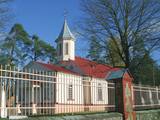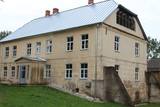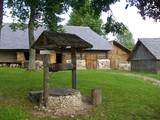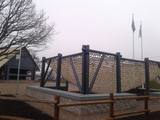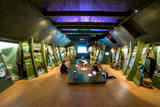| Nr | Name | Beschreibung |
|---|---|---|
|
72 types of wild rhododendrons with 193 different species
This is the only specialised rhododendron nursery in the Baltic States. Specialists there work on different kinds of rhododendrons, seeking to produce decorative and winter-resistant types of the flower. The nursery also sells plants. In the facility’s pine forest, which covers 11.8 hectares, you can see a large collection of rhododendrons from all over the world.
There are 64 winter-resistant types of rhododendrons at “Babīte,” including “Alma Mater,” “Academia Scientiarum,” “Emeritus,” “Eduards Smiļģis,” “Dita Krenberga,” and others (these were developed by Rihards Kondratovičs). All of these are appropriate for Northern Europe.
|
||
|
This is one of two crossing points across the Daugava (the other is near Līvāni). It is an exotic form of transportation to carry pedestrians, bicyclists and light automobiles across the river. There is a motor that operates a 200-metre metal cable. The crossing point is based on Soviet military pontoons that were used to build pontoon bridges for tanks. The crossing point was established by its owners. The Dunava Catholic Church is on the left bank of the river, and nearby is a monument to rafters. During the 1820s, there were three crossing points of this type across the Daugava. |
||
|
St. Cross Honouring Roman Catholic Church of Malta (Rozentova) is national architectural
monument. The church has a promiment „St. Mary Magdalene beside the Cross of Jesus” and three big
altars. The wooden log building was constructed in 1780. It was sanctified in 1782.
|
||
|
Das Café befindet sich im Zentrum von Kandava, unweit von dem Marktplatz. Gebäck, Kuchen, Torten, traditionelles Gericht Sklandrausis, Piroggen u.a. |
||
|
Der Fluss Daugava ist der größte Fluss in Lettland und der Schicksalsfluss des lettischen Volkes. Schon nach dem Ende der Eiszeit reisten auf das heutige Gebiet von Lettland durch das Tal des Flusses Daugava die ersten Pflanzen und Tiere ein, denen Menschen folgten. Das ist der Grund, warum das Ufer des Flusses Daugava einer der ältesten von Menschen bewohnten Orte, sowie das mit Pflanzenarten reichte Gebiet in Lettland ist. Auch die Dichte der ausgezeichneten Kulturdenkmäler und der historischen Denkmäler ist ein Grund, warum die Ufer des Flusses Daugava so beliebt sind. Auf der Strecke Rīga – Jēkabpils kann man bequem die Eisenbahnlinie Rīga – Daugavpils benutzen. Weiter sind Bahnhöfe angezeigt, an denen es auszusteigen wert ist, und kleine – einige Stunden bis einen halben Tag lange – radiale Wanderungen mit der Rückkehr am Bahnhof zu unternehmen. Route information from Latvijas Lauku forums |
||
|
The Ferris wheel that is in Sigulda is on the corner of Leona Paegles and Cēsu streets, and it is only open during the summer. If you ride the wheel, you can take lovely snapshots of the ancient Gauja River valley. |
||
|
Lai nokļūtu līdz šim tornim, ir jāveic apmēram 20 – 30 min ilgs pārgājiens pa dabas taku no Penijē muižas gar Penijegi (Penijõgi) kreiso krastu. Te redzami bebru darbi un to celtās zaru mājas. No torņa paveras skats uz Kazari deltu, kas dabā izpaužas kā monolīts un nepārskatāms niedrājs. To vairākās daļās sadala Kazari un mazāka izmēra upītes. Katrai deltas daļai ir savs vēsturiskais nosaukums: no torņa pa kreisi no Penijegi redzama Lihula meri (Lihulas „jūra”), bet tās labajā pusē - Kloostri meri (Klostri „jūra”). Putnu vērotāji var iziet garāku (7 km) dabas takas loku, kas ved pa palieņu pļavām. Jārēķinās, ka pavasaros būs nepieciešami piemēroti apavi! Pļavas ierobežotās platībās apsaimnieko mājdzīvnieki, tādēļ neaizmirstiet aizvērt vārtiņus aiz sevis un netraucējiet to ikdienas gaitas! No maršruta nav atļauts novirzīties, lai netraucētu putnus. |
||
|
Muižas dzīvojamā ēka līdz mūsdienām nav saglabājusies. Šodien Dvietes muižas parkā ir apskatāmas muižas pārvaldnieka māja un trīs mūra saimniecības ēkas. 19. gs. veidots ainavu parks ar laukakmeņu mūrējuma tiltu. Parkā atrodas Dvietes muižas ēkas. |
||
|
Der erste Teil dieses Abschnitts des Waldweges schlängelt sich entlang des herrlichen Piusa-Tals und biegt dann im Dorf Härmä in Richtung Obinitsa ab, einem wichtigen kulturellen Zentrum von Setomaa, dem Land von Setos. Hier können Sie die Traditionen der Seto-Bevölkerung entdecken, zum Beispiel das feine Handwerk der Seto-Frauen. Nach Obinitsa führt der Waldweg durch wunderschöne, heidereiche Kiefernwälder, steigt zurück in die Tiefen des Piusa-Tals und endet an den Piusa-Höhlen. Die Piusa-Sandsteinhöhlen sind das Ergebnis des Handabbaus von Glassand von 1922-1966. In den Höhlen befindet sich die größte überwinternde Fledermauskolonie Osteuropas. In Begleitung des Führers können Sie die Aussichtsplattform in der Museumshöhle besuchen. |
||
|
Diese Schmalspurbahn ist eine schöne Möglichkeit, zurück in die Vergangenheit zu kehren – in die Zeit, wenn auf dem Territorium Lettland eine Epoche der Schmalspurbahnen “herrschte”. Bis zu den 60er Jahren des vorigen Jahrhunderts war die Schmalspurbahn an der Küste von Nordkurland im Einsatz und verband die an der Küste liegenden Fischerdörfer. Bis heutzutage sind die Orte (nur kaum erkennbare Korridore im Hintergrund der Natur), einzelne Stationsgebäude oder die Reste erhalten. Im Freilichtmuseum von Ventspils kann man die 1,4 km lange Ringlinie oder 3 km Berglinie interessant fahren. Am Ende der Berglinie befindet sich eine Drehscheibe. Die Lokomotive der Schmalspurbahn ist 1916 in Deutschland gebaut worden. Man kann auch ein Stationsgebäude mit ganzer Ausrüstung besichtigen. |
||
|
Ein ethnographisches Gästehaus auf der Insel Muhu, in der historischen Siedlung Paenese. |
||
|
The farm produces tomatoes, cucumbers, red peppers, strawberries, apples, plums and cherries. The fruits and vegetables are available for purchase. |
||
|
Es ist ein eigenartiges Freilichtmuseum in Süd-Estland, was Schul-und Dorfleben am Ende des 19. Jh-s darstellt. Auf 5 ha Territorium sind Schulhaus mit Nebengebäuden, Gerichtshaus, Armenhaus, Vorratsmagazin, Wohnriege, Bauernhaus und holländische Windmühle. Exponiert sind auch historische Landmaschienen und Fahrzeuge. |
||
|
Here you will learn about home-based manufacturers, farms, companies and others in Latgale that produce various dairy products such as milk, yogurt, cottage cheese, cheese, ice cream, etc. Start in Preiļi, which is known as Latvia’s cheese capital. The route passes along the Teiči nature reserve, with a viewing tower at the side of the road, also crossing Lubāna wetlands, which are of European importance for environmental protection. Drive on to Rēzekne (churches, a monument to Māra of Latgale, “Gors,” “Zeimuļš”, etc.). Nature lovers will love the Rāzna National Park with Lake Rāzna, Mākoņkalns hill and the master ceramicist Evalds Vasiļevskis. From Dagda, head to Aglona, which is a centre for Roman Catholic worshippers, and Lake Rušons before returning to your starting point. |
||
|
Guest house “Hilda Villa” is located in Estonia, in Viljandi town center. Guest house has special family room for 4 person and smaller families also. On the first floor there are Hilda's room and the Tenant's room, bathroom, living room, and kitchen. On the second floor there are 3 bedrooms for accommodation, 2 showers, and 2 toilets. |
||
|
Meklējama Tārgales ciema centrā. 2018. g. nogalē atklāta Lībiešu zvejnieku sēta ar dzīvojamo māju, kurā ir saimes galds un soli, kūti, tīklu žāvētavu un mākslīgi radīts kāpas fragments. Sēta veidota kā atklāta tipa objekts un to var apmeklēt jebkurā laikā. Apkaimē saglabātas vietējās koku sugas. |
||
|
The Baltic Sea gave this territory one of the old names of Jūrkalne – Felixberg, and people still talk about the interesting legend that is the origin of the name. Several wrecked ships have been found in the Baltic Sea off the coast of Jūrkalne. An exhibition in the museum visualises the underwater world as the deck of a ship that has sunk into the depths of the sea. The exhibition focuses on the cultural and historical heritage of underwater Latvia, allowing visitors to learn all about the history of sailing ships, steamships and other objects that have been raised from the depths. Small children will start to learn about the underwater world, and researchers with broader knowledge will find something new here. |
||
|
This is the thickest wild pear tree in Latvia. The tree is particularly beautiful when it is blossoming.
|
||
|
Die Hauptstadt von Estland. Die Altstadt (auf der UNESCO-Liste des Weltkulturerbes) ist ein hervorragendes mittelalterliches Baudenkmal (14. – 15. Jh). Die ehemalige Hansestadt. |
||
|
This is one of the highest points among the hillocks of the Selonian area of Zemgale – Borīškalns Hill. From the tower, you will see Lake Sauka, as well as the forests and farmland which surround it. The “Kalna Ļūdāni” farm is nearby, and its owner uses his livestock to help to maintain the surrounding landscape.
|
||


